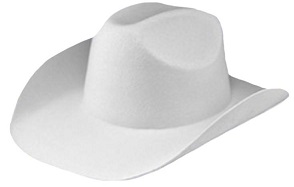Good verse evil can not easily be determined. However, if a hat color helps show a persons true colors, it certainly helps. White hat symbolism indicates that a white hat represents good. However, don't count on this in real life. It is mostly symbolism and obviously can't be used to determine a persons behaviors or characteristics. Don't judge a book by its cover. Also, don't judge a person by the color of hat they are wearing.
The term white hat refers idiomatically to an ethically good person, in this case one who has a righteous goal.
In United States films of the Western genre between the 1920s and the 1940s, white hats were often worn by heroes and black hats by villains to symbolize the contrast in good versus evil. The 1903 short film The Great Train Robbery was the first to apply this convention.
Although he wore a mask, The Lone Ranger was on the side of good. He wore a white hat, so obviously he was a good guy.

White hat symbolism has gone beyond cowboy films and TV shows.
Sailor Caps: Many Navy (armed forces; not the color navy) are white in color. United States Navy, Bolivian, Philippine, and Venezuelan sailors wear a white canvas hat with an upright brim, often referred to as a "Dixie cup" in reference to its similarity to the shape of a common disposable drinking cup, or a "gob hat" or cap.

This convention gave rise to the terms black hat and white hat to refer to malicious and ethical hackers respectively. Also, in regard to search engine optimization and other scenerios.
In reference to white hat computer security, the term "white hat" in Internet slang refers to an ethical computer hacker, or a computer security expert, who specializes in penetration testing and in other testing methodologies to ensure the security of an organization's information systems.
- One of the first instances of an ethical hack being used was a "security evaluation" conducted by the United States Air Force, in which the Multics operating systems was tested for "potential use as a two-level (secret/top secret) system." The evaluation determined that while Multics was "significantly better than other conventional systems," it also had "... vulnerabilities in hardware security, software security and procedural security" that could be uncovered with "a relatively low level of effort."
By 1981 The New York Times described white hat activities as part of a "mischievous but perversely positive 'hacker' tradition".
 White hat bias (WHB) is a phrase coined by public
health researchers David Allison and Mark Cope (2010) to describe a
purported "bias leading to the distortion of information in the service
of what may be perceived to be righteous ends", which consist of both
cherry picking the evidence and publication bias. Allison and Cope
explained the motivation behind this bias in terms of "righteous zeal,
indignation toward certain aspects of industry", and other factors
White hat bias (WHB) is a phrase coined by public
health researchers David Allison and Mark Cope (2010) to describe a
purported "bias leading to the distortion of information in the service
of what may be perceived to be righteous ends", which consist of both
cherry picking the evidence and publication bias. Allison and Cope
explained the motivation behind this bias in terms of "righteous zeal,
indignation toward certain aspects of industry", and other factors
You may also have interest in learn about the black hat which is the other side of the coin.
Learn more about hats in our apparel definitions section.
Thank you for using the Apparel Search website.
